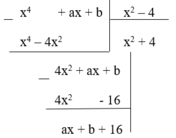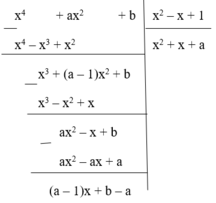
Hãy nhập câu hỏi của bạn vào đây, nếu là tài khoản VIP, bạn sẽ được ưu tiên trả lời.


a: \(\Leftrightarrow2x^2+8x+\left(a-8\right)x+4\left(a-8\right)-4a+28⋮x+4\)
hay a=7

\(a,4x^3+ax+b⋮x-2\\ \Leftrightarrow4x^3+ax+b=\left(x-2\right)\cdot a\left(x\right)\)
Thay \(x=2\Leftrightarrow32+2a+b=0\Leftrightarrow2a+b=-32\left(1\right)\)
\(4x^3+ax+b⋮x+1\\ \Leftrightarrow4x^3+ax+b=\left(x+1\right)\cdot b\left(x\right)\)
Thay \(x=-1\Leftrightarrow-4-a+b=0\Leftrightarrow a-b=-4\left(2\right)\)
Từ \(\left(1\right)\left(2\right)\) ta có hệ \(\left\{{}\begin{matrix}2a+b=-32\\a-b=-4\end{matrix}\right.\Leftrightarrow\left\{{}\begin{matrix}3a=-36\\b=a+4\end{matrix}\right.\Leftrightarrow\left\{{}\begin{matrix}a=-12\\b=-8\end{matrix}\right.\)

Đặt phép chia sau đo tính số dư
Vì x4+1 chia hết cho x2+ax +b ∀ x
⇒ số dư = 0 ⇒ từng cái = 0 ⇒ a= ; b =

Ta có

để x 4 + ax + b chia hết cho x 2 – 4 thì ax + b + 16 = 0
ó a x = 0 b + 16 = 0 ó a = 0 b = - 16
Đáp án cần chọn là: A

Ta có

Phần dư của phép chia là R = (a – 1)x + b – A. Để phép chia trên là phép chia hết thì R = 0, Ɐx
ó (a – 1)x + b – a = 0, Ɐx
ó a - 1 = 0 b - a = 0 ó a = 1 b = 1 ó a = b
Đáp án cần chọn là: C


\(1,A⋮B\Leftrightarrow x^3-3x^2-ax+3=\left(x-1\right)\cdot a\left(x\right)\)
Thay \(x=1\)
\(\Leftrightarrow1-3-a+3=0\\ \Leftrightarrow a=1\)
\(2,A⋮B\Leftrightarrow3x^3-16x^2+25x+a=\left(x^2-4x+3\right)\cdot b\left(x\right)\\ \Leftrightarrow3x^3-16x^2+25x+a=\left(x-3\right)\left(x-1\right)\cdot b\left(x\right)\)
Thay \(x=1\)
\(\Leftrightarrow3-16+25+a=0\\ \Leftrightarrow a=-12\)
Thay \(x=3\)
\(\Leftrightarrow3\cdot27-16\cdot9+25\cdot3+a=0\\ \Leftrightarrow81-144+75+a=0\\ \Leftrightarrow12+a=0\Leftrightarrow a=-12\)
Vậy \(a=-12\)

A(x)=(1-x^n)(1+x^n)/(1-x)(1+x)
B(x)=1-x^n/1-x
A(x) chia hết cho B(x) khi 1-x^n chia hết cho 1+x
x^n+1/x+1=A(x)+(1+(-1)^n)/(x+1)
=>1-x^n chia hết cho 1+x khi và chỉ khi n=2k+1